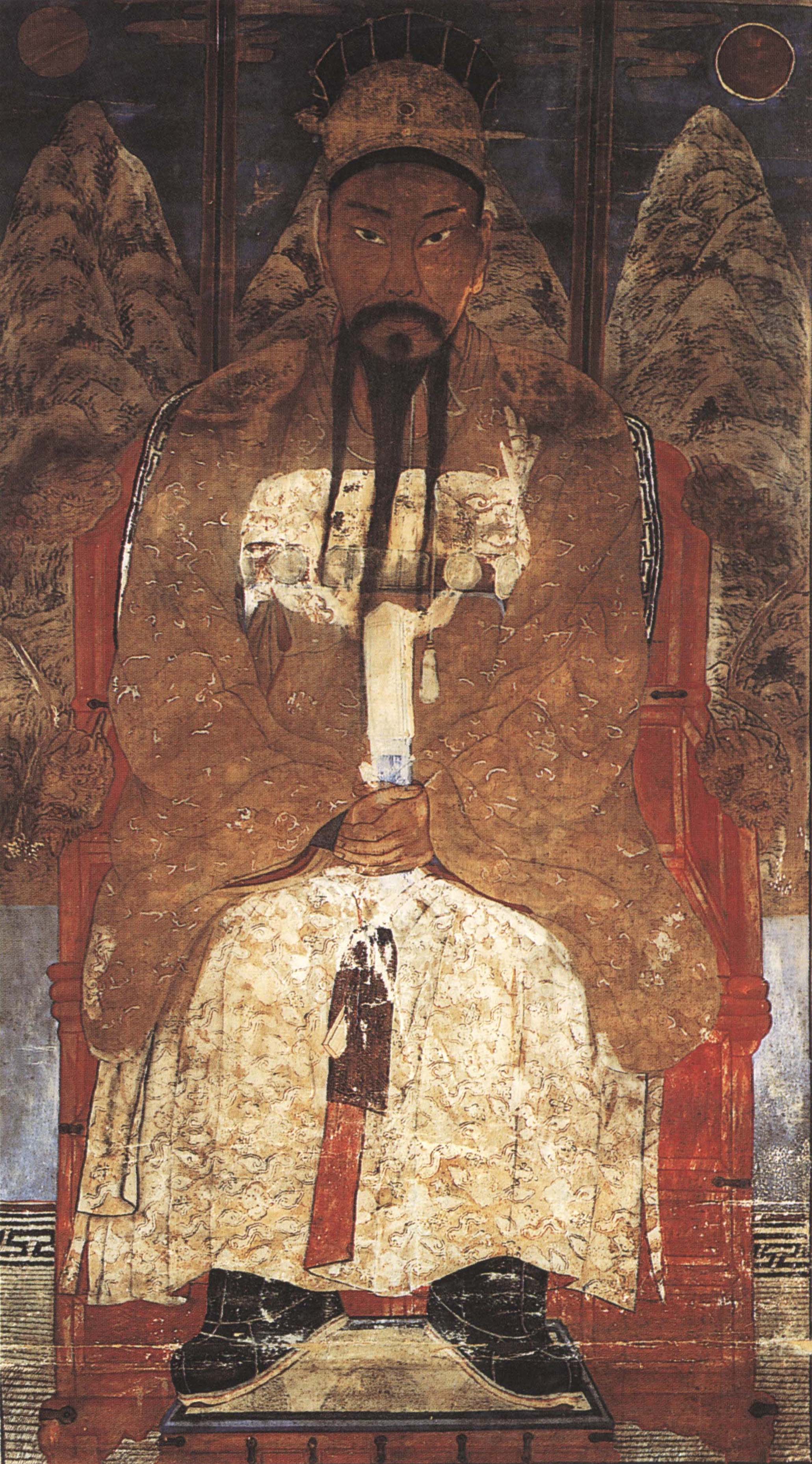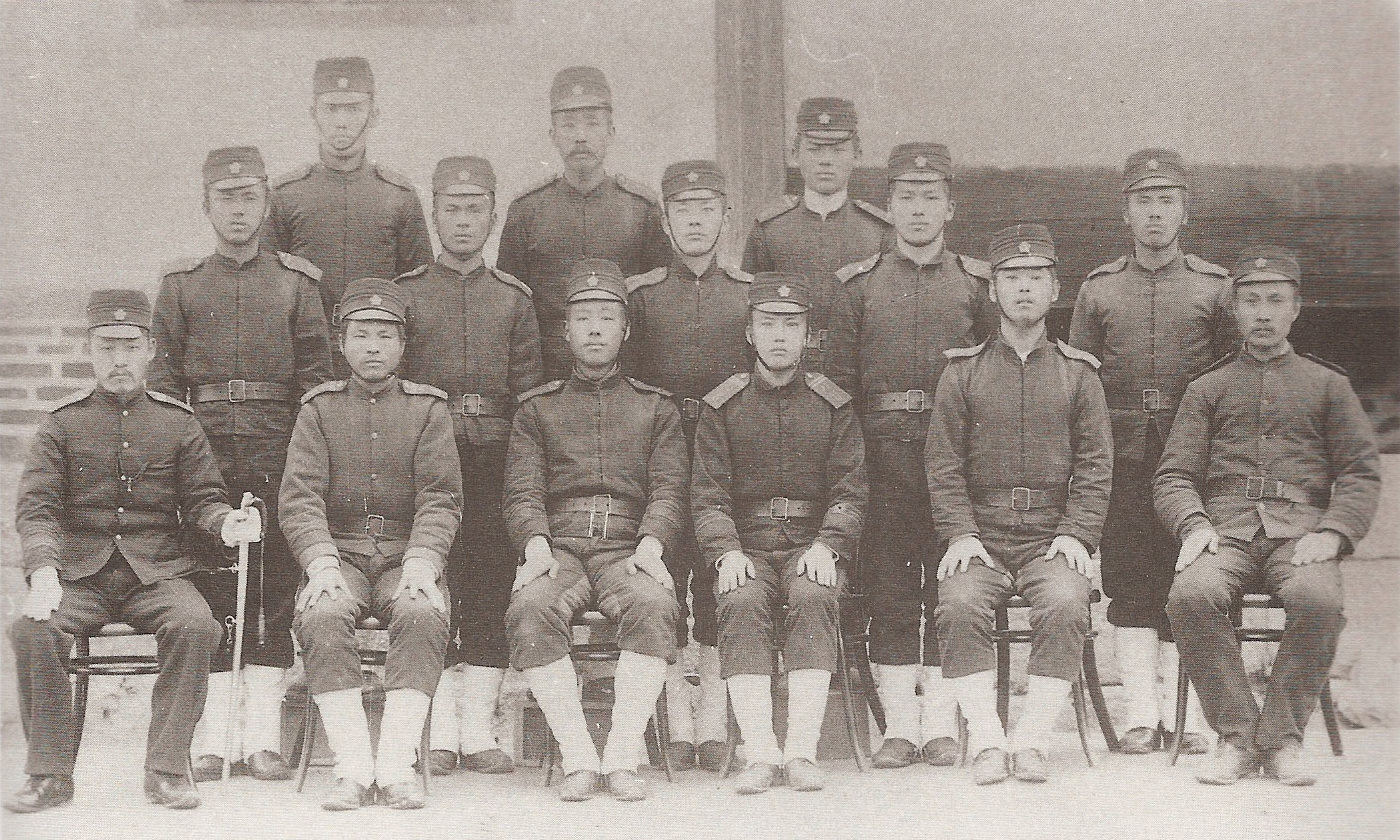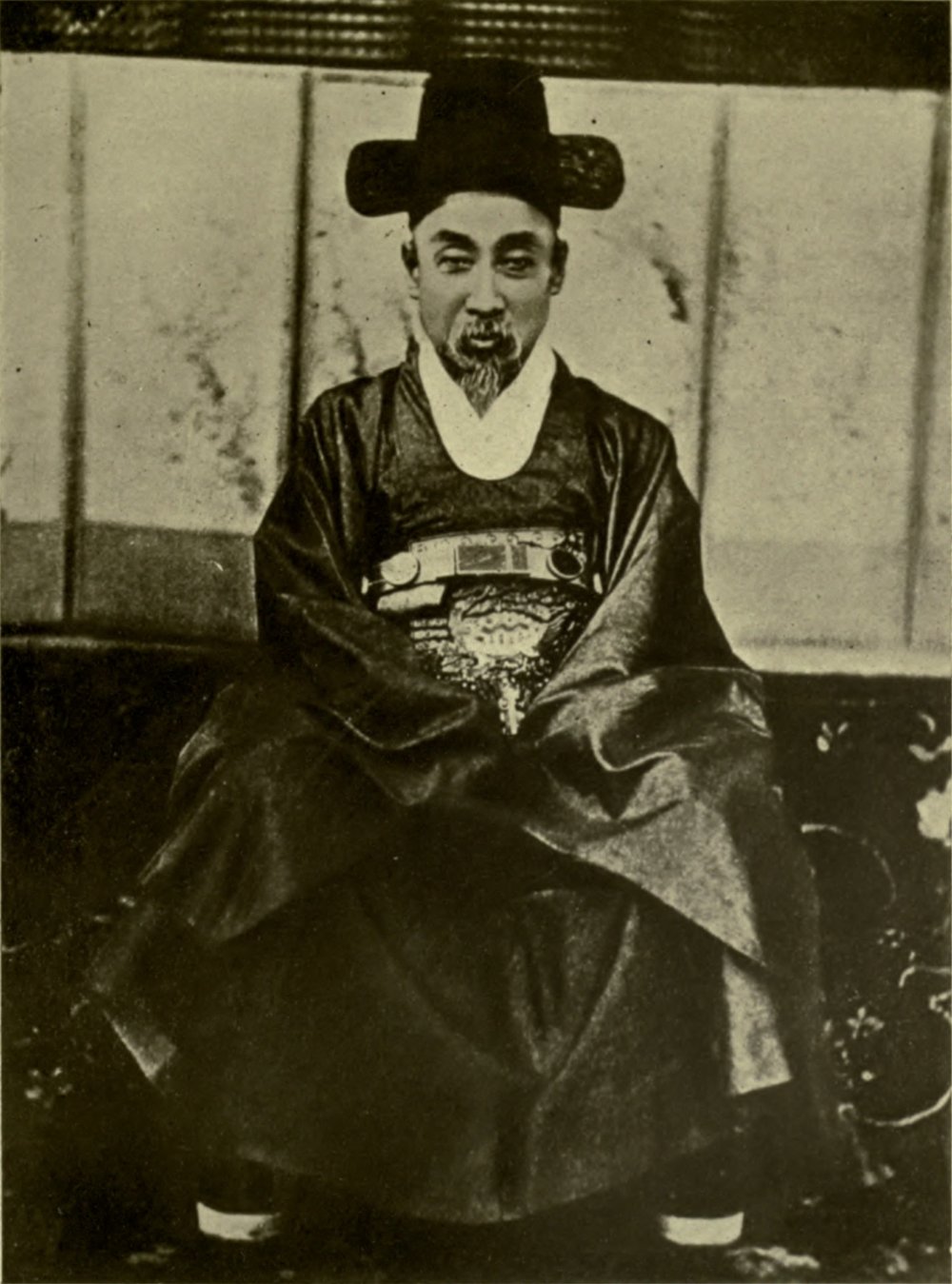|
Emperor Sunjong
Sunjong (; 25 March 1874 – 24 April 1926), personal name Yi Cheok (), also known as the Yunghui Emperor (), was the last Korean monarch. He ruled from 1907 to 1910 as the second and last emperor of the Korean Empire. Sunjong was elevated to the throne after his predecessor and father, Gojong, was forced to abdicate by the Empire of Japan. Hence, Sunjong has been characterized by historians as being a powerless puppet ruler of the Japanese, reigning for just three years before Korea was officially annexed in 1910. Biography Crown Prince of Korea Sunjong was the second son of Emperor Gojong and Empress Myeongseong. When he turned two years old in 1876, Sunjong was proclaimed the Crown Prince of Joseon. He was intellectually disabled and described as "mentally retarded". In 1882, he married a woman of the Yeoheung Min clan (later Empress Sunmyeonghyo). She died at the age of 31 on 5 November 1904 due to a severe depression, after trying to protect her mother-in-law (Emp ... [...More Info...] [...Related Items...] OR: [Wikipedia] [Google] [Baidu] |
List Of Monarchs Of Korea
This is a list of monarchs of Korea, arranged by dynasty. Names are romanized according to the South Korean Revised Romanization of Korean. McCune–Reischauer romanizations may be found at the articles about the individual monarchs. Gojoseon Gojoseon (2333 BC – 108 BC) was the first Korean kingdom. According to legend, it was founded by Dangun in 2333 BC. Bronze Age archaeological evidence of Gojoseon culture is found in northern Korea and Liaoning. By the 9th to 4th century BC, various historical and archaeological evidence shows Gojoseon was a flourishing state and a self-declared kingdom. Both Dangun and Gija are believed to be mythological figures, but recent findings suggest and theorize that since Gojoseon was a kingdom with artifacts dating back to the 4th millennium BC, Dangun and Gija may have been royal or imperial titles used for the monarchs of Gojoseon, hence the use of Dangun for 1900 years. * : "An extreme manifestation of nationalism and the family cult was ... [...More Info...] [...Related Items...] OR: [Wikipedia] [Google] [Baidu] |
Encyclopedia Of Korean Culture
The ''Encyclopedia of Korean Culture'' () is a Korean-language encyclopedia published by the Academy of Korean Studies and DongBang Media Co. It was originally published as physical books from 1991 to 2001. There is now an online version of the encyclopedia that continues to be updated. Overview On September 25, 1979, a presidential order (No. 9628; ) was issued to begin work on compiling a national encyclopedia. Work began on compiling the encyclopedia on March 18, 1980. It began publishing books in 1991. The encyclopedia's first version was completed, with 28 volumes, in 1995. It continued to be revised beginning in 1996. In 2001, the digital edition EncyKorea was published on CD-ROM A CD-ROM (, compact disc read-only memory) is a type of read-only memory consisting of a pre-pressed optical compact disc that contains computer data storage, data computers can read, but not write or erase. Some CDs, called enhanced CDs, hold b ... and DVD. It launched an online version in 20 ... [...More Info...] [...Related Items...] OR: [Wikipedia] [Google] [Baidu] |
Veritable Records Of The Joseon Dynasty
The ''Veritable Records of the Joseon Dynasty'', sometimes called ''sillok'' () for short, are state-compiled and published records, called Veritable Records, documenting the reigns of the kings of the Joseon dynasty in Korea. Kept from 1392 to 1865, they comprise 1,893 volumes and are thought to be the longest continual documentation of a single dynasty in the world. The records of the last two monarchs are believed to have been influenced by the Japanese colonial rule and, therefore, their credibility compromised. Excluding the records of the last two kings, the ''sillok'' is designated as the 151st national treasure of South Korea and listed in UNESCO's Memory of the World registry. In 2006, the annals were digitized and made available online by the National Institute of Korean History. Both a modern-Korean translation in hangul and the original in Classical Chinese are available. In January 2012, the National Institute of Korean History announced a plan to transla ... [...More Info...] [...Related Items...] OR: [Wikipedia] [Google] [Baidu] |
Yoon Taek-young
Yoon may refer to: *Yoon (Korean name), the ninth most common Korean family name. *Yoon, stage name of Shim Ja-yoon, member of K-Pop group STAYC. *Yōon, a feature of the Japanese language. *Prabda Yoon (born 1973), a Thai novelist. *Yoon Suk Yeol Yoon Suk Yeol (; born 18 December 1960) is a South Korean politician and former prosecutor who served as the 13th president of South Korea from 2022 until Impeachment of Yoon Suk Yeol, he was removed from office in 2025. The shortest-serving ..., the 20th president of South Korea. See also * Yun (other) {{Disambiguation ... [...More Info...] [...Related Items...] OR: [Wikipedia] [Google] [Baidu] |
Military Of The Korean Empire
The Imperial Korean Armed Forces (대한제국군) was the military of the Korean Empire. History Foundation Succeeding the Joseon Army (late 19th century), Joseon Army and Joseon Navy, Navy, the Gwangmu Reform reorganized the military into a modern western-style military. The foundation of the Imperial Korean Army started when Inoue Kaoru argued that the King should modernize the military and the commanding system in 1895. Korea established many military academies in Korea. Gojong of Korea tried to install his guards, but because of the interruptions of Japan, it was hard to use the Capital Guards (''Siwidae'',(시위대), (侍衛隊)) as his palace guards. But when the Japanese were being interrupted by other European countries, the ''Siwidae'' was formed as Gojong's guards. The minister of the military supervises the training of the ''Siwidae''. However, the ''Siwidae'' was disbanded in August of that year for failing to stop the Japanese from assassinating Empress Myeongse ... [...More Info...] [...Related Items...] OR: [Wikipedia] [Google] [Baidu] |
Field Marshal
Field marshal (or field-marshal, abbreviated as FM) is the most senior military rank, senior to the general officer ranks. Usually, it is the highest rank in an army (in countries without the rank of Generalissimo), and as such, few persons are ever appointed to it. It is considered as a five-star rank (OF-10) in modern-day armed forces in many countries. Promotion to the rank of field marshal in many countries historically required extraordinary military achievement by a general (a wartime victory). However, the rank has also been used as a Division (military), divisional command rank and as a brigade command rank. Examples of the different uses of the rank include Afghanistan, Austria-Hungary, India, Pakistan, Prussia/Germany and Sri Lanka for an extraordinary achievement; Spain and Mexico for a divisional command (); and France, Portugal and Brazil for a brigade command (, ). Origins The origin of the term dates to the early Middle Ages, originally meaning the keeper of t ... [...More Info...] [...Related Items...] OR: [Wikipedia] [Google] [Baidu] |
Assassination Of Empress Myeongseong
Around 6a.m. on 8 October 1895, Empress Myeongseong, Queen Min, the consort of the Korean monarch Gojong of Korea, Gojong, was assassinated by a group of Japanese agents under Miura Gorō. After her death, she was posthumously given the title of "Empress Myeongseong". The attack happened at the royal palace Gyeongbokgung in Seoul, Joseon. This incident is known in Korea as the Eulmi Incident. By the time of her death, the queen had acquired arguably more political power than even her husband. Through this process, she made many enemies and escaped a number of assassination attempts. Among her opponents were the king's father the Heungseon Daewongun, the pro-Japanese ministers of the court, and the Korean army regiment that had been trained by Japan: the Hullyŏndae. Weeks before her death, Japan replaced their emissary to Korea with a new one: Miura Gorō. Miura was a former military man who professed to being inexperienced in diplomacy, and reportedly found dealing with the powerf ... [...More Info...] [...Related Items...] OR: [Wikipedia] [Google] [Baidu] |
Empress Sunmyeonghyo
Empress Sunmyeonghyo or literally known as Sunmyeong, the Filial Piety Empress (; 8 November 1872 – 23 October 1904), of the Yeoheung Min clan, was the first wife and Crown Princess Consort of Crown Prince Yi Cheok, who later became the last emperor of the Korean Empire. Biography Lady Min was born on 20 November 1872 into the Yeoheung Min clan to Min Tae-ho, leader of the Yeoheung Min clan, and his second wife, Lady Song of the Jincheon Song clan. She had an older half-brother and one younger brother. It was said that her family was poor when she was young until her older half-brother, Min Yeong-ik, became the adoptive son of Min Seung-ho; who was a relative of the clan. This was because Min Seung-ho was the adoptive son of Min Chi-rok, the father of Empress Myeongseong. Thus making her adoptive uncle the adoptive older brother of Empress Myeongseong who became Queen in 1866 which helped her family thrive. Despite having another son, her father adopted another son fro ... [...More Info...] [...Related Items...] OR: [Wikipedia] [Google] [Baidu] |
Yeoheung Min Clan
The Yeoheung Min clan () is a Korean clan that traces its origin to Yeoju, Gyeonggi Province. The 2015 Korean census counted 167,124 members of the Yeoheung Min clan. Origin The progenitor of the Yeoheung Min clan was long thought to be Min Ching-do (민칭도, 閔稱道), who settled in Goryeo after serving as an emissary from the Song dynasty. Min Ching-do was believed to descend from Min Sun, the second brightest disciple of Confucius. However, this story is most likely a later fabrication during Goryeo dynasty. Another theory suggests the clan originated from Yeongwollu Mingul Maamgul in Hyang-ri, Yeoju (영월루 민굴, 마암굴 閔窟;여주). This speculation stems from a poem by Yi Kyu-bo to Min Sik, asserting Min Sik's lineage from Min Ja-geon ( Min Sun) and Yi Kyu-bo's own descent from the legendary Chinese philosopher Laozi. However, skepticism arises due to the poem's ulterior motive— Yi Kyu-bo's attempt to secure a government position (벼슬) by flattering ... [...More Info...] [...Related Items...] OR: [Wikipedia] [Google] [Baidu] |
Intellectual Disability
Intellectual disability (ID), also known as general learning disability (in the United Kingdom), and formerly mental retardation (in the United States), Rosa's Law, Pub. L. 111-256124 Stat. 2643(2010).Archive is a generalized neurodevelopmental disorder characterized by significant impairment in intellectual and adaptive functioning that is first apparent during childhood. Children with intellectual disabilities typically have an intelligence quotient (IQ) below 70 and deficits in at least two adaptive behaviors that affect everyday living. According to the DSM-5, intellectual functions include reasoning, problem solving, planning, abstract thinking, judgment, academic learning, and learning from experience. Deficits in these functions must be confirmed by clinical evaluation and individualized standard IQ testing. On the other hand, adaptive behaviors include the social, developmental, and practical skills people learn to perform tasks in their everyday lives. Deficits in ... [...More Info...] [...Related Items...] OR: [Wikipedia] [Google] [Baidu] |
Korea
Korea is a peninsular region in East Asia consisting of the Korean Peninsula, Jeju Island, and smaller islands. Since the end of World War II in 1945, it has been politically Division of Korea, divided at or near the 38th parallel north, 38th parallel between North Korea (Democratic People's Republic of Korea; DPRK) and South Korea (Republic of Korea; ROK). Both countries proclaimed independence in 1948, and the two countries fought the Korean War from 1950 to 1953. The region is bordered by China to the north and Russia to the northeast, across the Yalu River, Amnok (Yalu) and Tumen River, Duman (Tumen) rivers, and is separated from Japan to the southeast by the Korea Strait. Known human habitation of the Korean peninsula dates to 40,000 BC. The kingdom of Gojoseon, which according to tradition was founded in 2333 BC, fell to the Han dynasty in 108 BC. It was followed by the Three Kingdoms of Korea, Three Kingdoms period, in which Korea was divided into Goguryeo, Baekje, a ... [...More Info...] [...Related Items...] OR: [Wikipedia] [Google] [Baidu] |
Puppet Ruler
A puppet ruler is someone who holds a title of political authority, but is loyal to or controlled by outside persons or groups. When a foreign government wields such outside control, the puppet ruler's territory is referred to as a puppet state. Internal factors, such as non-elected officials, may also exert power over the puppet monarch. A figurehead monarch, as a source of legitimacy and perhaps divine reign, has been the used form of government in numerous circumstances and places throughout history. There are two basic forms of puppet monarchs: a figurehead monarch who is a puppet of another person or a group in the country who rules instead of the nominal ruler; and a puppet government under a foreign power. Examples of the first type are the Emperors who were the puppets of the shōguns of Japan and the kings who were the puppets of the Mayor of Palace in the Frankish kingdom. Client kingdoms under the Roman Republic and Roman Empire and the British Empire's colonial r ... [...More Info...] [...Related Items...] OR: [Wikipedia] [Google] [Baidu] |



